2018 年广西民族大学翻译硕士英语考研真题 A 卷
Part I. Basic English Knowledge (30%)
Section A: Multiple-choice (20 %)
Directions: There are forty multiple-choice questions in this section. Choose the
best answer to each question. Write your answers on the Answer Sheet.
1.Her work in genetics won United States scientist Barbara McClintock ---- -
in 1983.
B. the Nobel Prize was
A. was the Nobel Prize
C. the Nobel Prize
2.You can count how many students passed an exam, but psychological and emotional
feelings cannot be _______ measured.
D. for the Nobel Prize.
A. precisely
B. precise
C. preciously
D. precious
3.Unemployment has come down slightly, but this does not ______ the fact that it
is still a major problem.
A. alert
B. alter
C. alarm
D. altar
4.The man breathed a sign of ______ when he was told that everything had arrived
in good condition.
A. receive
B. relieve
C. relief
D. release
5.Artificial light _______ the respiratory activity of some microorganisms in the
winter but not in the summer, in part because in the summer their respiration is
already at its peak and thus cannot be _______.
A. stimulates… lessened
B. B. elevates… quickened
C. C. reflects.. .expanded
D. D. enhances… increased
6.Because they have been so dazzled by the calendars and the knowledge of astronomy
�
possessed by the Mayan civilization, some anthropologists have_______ achievements
like the sophisticated carved calendar sticks of the Winnebago people.
A. described
B. acknowledged C. overlooked
D, defended
7.Even those siblings whose childhood was_______ familial feuding and intense
rivalry for their parents’ affection can nevertheless develop congenial and even
_______relationships with each other in their adult lives.
A, scarred by.. .vitriolic
B, filled with… tolerant
C, dominated by… intimate
D, replete with.. .competitive
8.Working for 10 hours per week or less seemingly does not take a consistent _____
on school performance.
A. tool
B. toll
C. toller
D. tollen
9. He said he wished to ______ in the army during the last three years.
A. be served
B.
be serving
C. serve
D. have been serving
10. ________ much you may dislike it, junk mail comes to most of you anyway.
A. Whatever B. Whichever
C.
Whenever
D. However
11. The increased use of computers in business has been_______ by a costly increase
in computer crime.
A. accompanied
B. disappointed C. matched
D. witnessed
12.Many animals display______
helpless.
instincts only while their offspring are young and
A. cerebral B. imperious
C. rueful
D. maternal
13. Because of its importance in modern living, ______in all parts of the
world.
�
A. in schools and colleges are algebra studies
B. studying algebra in schools and colleges
C. and the study of algebra in schools and colleges
D. algebra is studied in schools and colleges
14.______touching in O Henry's stories is the gallantry with which ordinary people
struggle to maintain their dignity.
A. Most is
B. Is mostly
C. Is it most
D. What is most
At the Seventh International Ballet Competition,Femando Bujones won the first
15.
gold medal ever_________to a United States male dancer.
A.to be awarded
B.to award C.that awards
D.should be awarding
16. I was awfully tired when I got home from work, but a half hour nap ____me.
A. relieved B. released C. revived
D. recovered
17. The new technological revolution in American newspapers has brought increased_
a wider range
of publications and an expansion of newspaper job.
A. reproduction B. circulation
C. manipulation D. penetration
18.Geophysicists have collaborated with archaeologists and anthropologists to
study the magnetic properties of pottery and fireplaces at sites _________by early
humans.
A. occupied B. occupying
C. which
D. were occupied
19. The story that follows__ two famous characters of the Rocky Mountain gold rush
days.
A. concerns B. states
C. proclaims
D. relates
20.There is a general understanding among the members of the Board of Directors
�
that chief attention
____to the undertaking that is expected to bring highest profit.
A. is given B. gives
C. must be given
D. be given
Section B:
Proofreading and Error Correction (10 %)
Directions: The following passage contains 10 errors. Each indicated line contains
a maximum of ONE error. In each case, only ONE word is involved. You should proofread
the passage and correct it. Please write your answers on the Answer Sheet.
Dinosaurs, saber-tooth tigers and the dodo bird are famous examples (21)
__
____
of animals that have become extinct. In case of the dinosaurs, it
(22)
seems likely that a catastrophic event alters the global climate
(23)
enough to lead to their disappearance. More recent extinctions
and near-extinctions-such as the blue whales, tiger, panda, and
(24)
North American bison—have been the direct result of human activity.
By the early 1990s, species were becoming extinct at a rate of three
per hour, or 27,000 every day – a figure quoted by the American
biologist Edward O.Wilson of Harvard University, based on his
most conservative estimates. This rate of extinctions carries with
it some terrible consequences. Each plant that becomes extinct,
for example, may take with it as much as 30 insects and animals (25)
that depend on it for food. Habitat loss is one of the most important
causes of extinction. For rising populations in many countries
lead to the clearing of more land, habitats such as raining forest
and grasslands disappear.
In the East Africa, once renowned for its wildlife, few wild animals
remain living outside the boundaries of national parks and game (29)
reserves. In other parts of the world, coastal ecosystems are clearing
(26)
(27)
(28)
(30)
�
for development. Wetland areas are drying out as a result of water
extraction to support farming and tourism. Bird species are among
the worst affected by the loss of wetlands.
Part II.
Reading Comprehension (50 %)
Section A (30 %)
Directions: There are 2 passages in this section. Each passage is followed by some
questions or unfinished statements. For each of them there are four choices marked
A), B), C) and D).You should decide on the best choice and write your answers on
the Answer Sheet.
Passage 1
He emerged, all of a sudden, in 1957: the most explosive new poetic talent of the
English post-war era. Poetry specialized, at that moment, in the wry chronicling
of the everyday. The poetry of Yorkshire-born Ted Hughes, first published in a book
called “The Hawk in the Rain” when he was 27, was unlike anything written by his
immediate predecessors. Driven by an almost Jacobean rhetoric, it had a visionary
fervour. Its most eye-catching characteristic was Hughes's ability to get beneath
the skins of animals: foxes, otters, pigs. These animals were the real thing all
right, but they were also armorial devices—symbols of the countryside and lifeblood
of the earth in which they were rooted. It gave his work a raw, primal stink.
It was not only England that thought so either. Hughes's book was also published
in America, where it won the Galbraith prize, a major literary award. But then,
in 1963, Sylvia Plath, a young American poet whom he had first met at Cambridge
University in 1956, and who became his wife in the summer of that year, committed
suicide. Hughes was vilified for long after that, especially by feminists in America.
In 1998, the year he died, Hughes broke his own self-imposed public silence about
their relationship in a book of loose-weave poems called “Birthday Letters”. In
this new and exhilarating collection of real letters, Hughes returns to the issue
of his first wife's death, which he calls his “big and unmanageable event”. He
felt his talent muffled by the perpetual eavesdropping upon his every move. Not
until he decided to publish his own account of their relationship did the burden
begin to lighten.
The analysis is raw, pained and ruthlessly self-aware. For all the moral torment,
the writing itself has the same rush and vigour that possessed Hughes's early poetry.
Some books of letters serve as a personalized historical chronicle. Poets' letters
are seldom like that, and Hughes's are no exception. His are about a life of literary
engagement: almost all of them include some musing on the state or the nature of
writing, both Hughes's own or other people's. The trajectory of Hughes's literary
�
career had him moving from obscurity to fame, and then, in the eyes of many, to
life-long notoriety. These letters are filled with his wrestling with the
consequences of being the part-private, part-public creature that he became,
desperate to devote himself to his writing, and yet subject to endless invasions
of his privacy.
Hughes is an absorbing and intricate commentator upon his own poetry, even when
he is standing back from it and good-humouredly condemning himself for “ its
fantasticalia, its pretticisms and its infinite verballifications ” . He also
believed, from first to last, that poetry had a special place in the education of
children. “What kids need”, he wrote in a 1988 letter to the secretary of state
for education in the Conservative government, “is a headfull [sic] of songs that
are not songs but blocks of refined and achieved and exemplary language.” When
that happens, children have “the guardian angel installed behind the tongue”.
Lucky readers, big or small.
31.The poetry of Hughes’s forerunners is characteristic of ______
A. its natural, crude flavor.
B. its distorted depiction of people’s daily life.
C. its penetrating sight.
D. its fantastical enthusiasm.
32.The word “vilified” (Line 4, Paragraph 2)most probably means _____.
A. tortured B. harassed C. scolded
D. tormented
33.According to the third paragraph, Hughes’s collection of letters are _____
A. the exact reason responsible for both his fame and notoriety.
B. personalized description of his double identity as a public and a private figure.
C. reflections of his struggle between his literary devotion and the reality.
D. his meditation and exploration on the literary world and the essence of
literature.
34.From the letters, we may find the cause of Hughes’s internal struggle is _____
A.his eager and unsatisfied passion for literature.
B.that he is a part-private, part-public creature.
C.that he is constrained by the fear of his privacy being exposed to the criticism
of the public.
�
D.the moral torment exerted by himself.
35.By “lucky readers” in the last sentence, the author means_____
A.children who are imparted with the beauty and wisdom of poetry.
B.children who have a headfull of fantastic and verbally perfect songs.
C.children who own blocks of refined and achieved and exemplary language.
D.children who are believed to have the guardian angel installed behind the tongue.
Passage 2
Everyone is interested in whether different foods or nutrients affect our odds of
getting diseases like cancer or of developing risk factors for those diseases, such
as too much weight or high blood pressure. But there are many barriers to studying
dietary change, which is why we still have no easy answers to the question of what,
exactly, we should eat to be at our healthiest. It's also why you can be forgiven
for often feeling whipsawed by headlines: Is coffee good or bad? What about alcohol,
garlic, or chocolate?
This week researchers reported in the Journal of the American Medical Association
that breast cancer survivors who cram their diets with fruits and vegetables are
no more likely to escape a recurrence than women who stick to the usual five-a-day
recommendation. Does that mean fruits and vegetables don't protect against cancer?
No—just that in this specific group of women with breast cancer, the extra greens
and additional apples didn't seem to help.
We asked researchers to explain why studies involving dietary changes are so hard
to do—and what consumers should keep in mind when they read about them. Here's
what the experts said:
Most diet studies take place in the real world. That means study subjects are keeping
diaries of what they eat as they go rather than having their intake strictly
controlled by someone else. You can give them meal advice, counseling, and how-to
books up to their ears, but at the end of the day, they are on their own when it
comes to what they put in their mouths. It's easier to get people to add something
—like garlic, in the form of tasty sandwich spreads, or dark chocolate—than to
take something away; no wonder a recent study comparing low-fat and low-carb diet
plans found that almost no one was sticking to them by the end.
In studies focusing on diet, including the recent study on breast cancer recurrence,
the amount of calories subjects reported eating would have caused them to lose far
more weight than they actually did lose. The misreporting isn't necessarily vicious,
but the inaccuracies add up. Say you're phoned about your daily intake on a day
�
when it was someone's birthday at work and you had a slice of cake. You may not
report it, thinking that a typical day wouldn't include the cake...forgetting
yesterday's "special occasion" piece of pizza, and the Big Gulp of the day before.
Or, despite the portion size guides you get, you characterize your bagel from the
deli as a 4-ounce standard serving when a 4-ounce bagel hasn't been sighted in any
major city for a decade.
"You can't put a camera in everyone's belly and see exactly what they ate," says
Christopher Gardner, a nutrition scientist at the Stanford Prevention Research
Center who has recently published research on garlic and diet plans. You can get
around this in some studies by taking objective measurements. Weight, for example,
or if you're assessing intake of fruits and veggies, you can measure the level of
pigments called carotenoids in the blood. In the breast cancer study, blood tests
showed that the study subjects actually did eat more fruits and veggies (carotenoid
concentration was 73 percent higher in those women after one year and 43 percent
higher after four years). But objective measures can't definitively nail down
whether someone is eating nutrients in certain proportions.
36.One can be forgiven for feeling whipsawed by feeling whipsawed by those headlines
because_____
A.there is no solid and convincing scientific hypothesis on these subjects.
B.they question about what the healthiest food is has no answers.
C.opinions on these subjects are quite contradictory.
D.there is no authoritative answer to these questions.
37.Which one of the following statements is TURE of the conclusion of the study
on breast cancer recurrence ?
A. Women who stick to the five-a-day recommendation are less likely to have a
recurrence.
B. Women who eat extra greens and vegetables are less likely to escape a recurrence.
C. Women could not depend on fruit diet to avoid the breast cancer recurrence.
D. Fruits and vegetables are no good to women with breast cancer.
38.From the results of the studies focusing on diet, it can be inferred that_____
A. the amount of calories set in diet could not help people to lose weight.
�
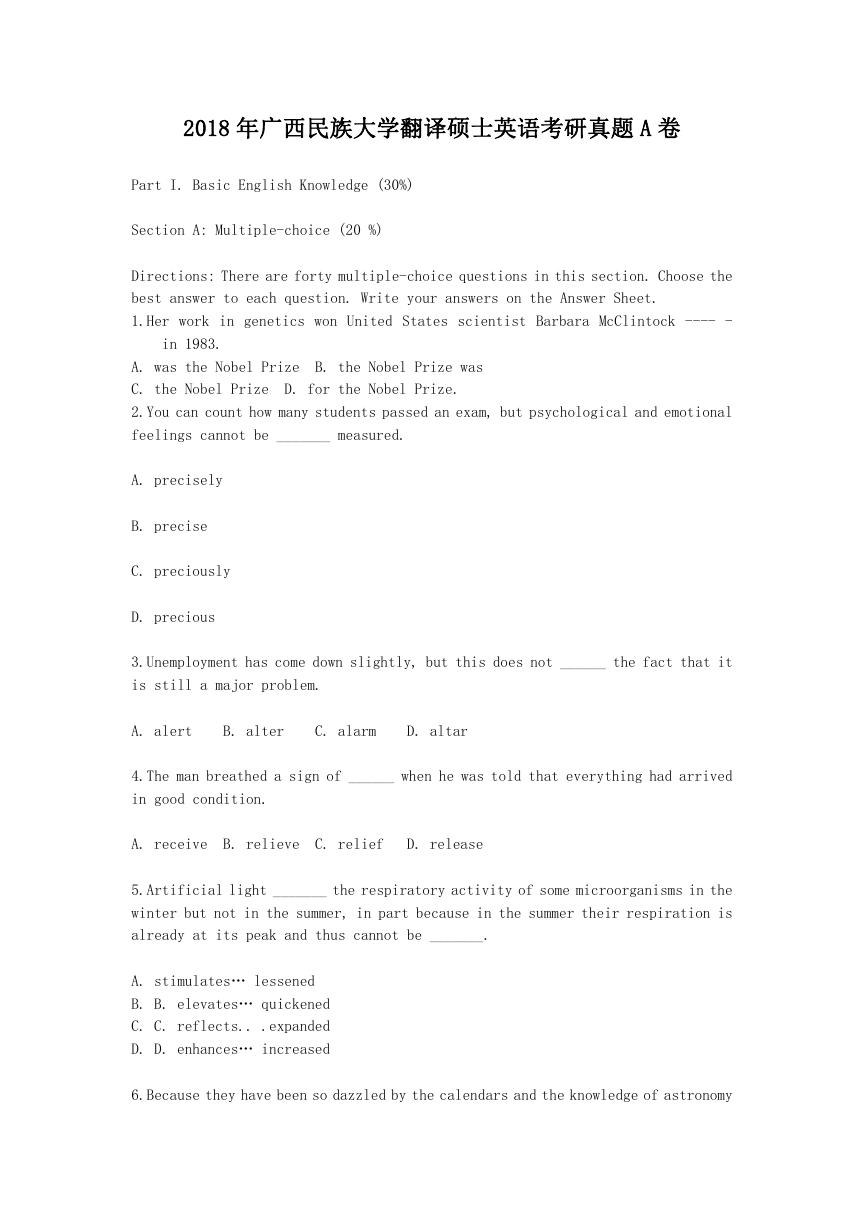
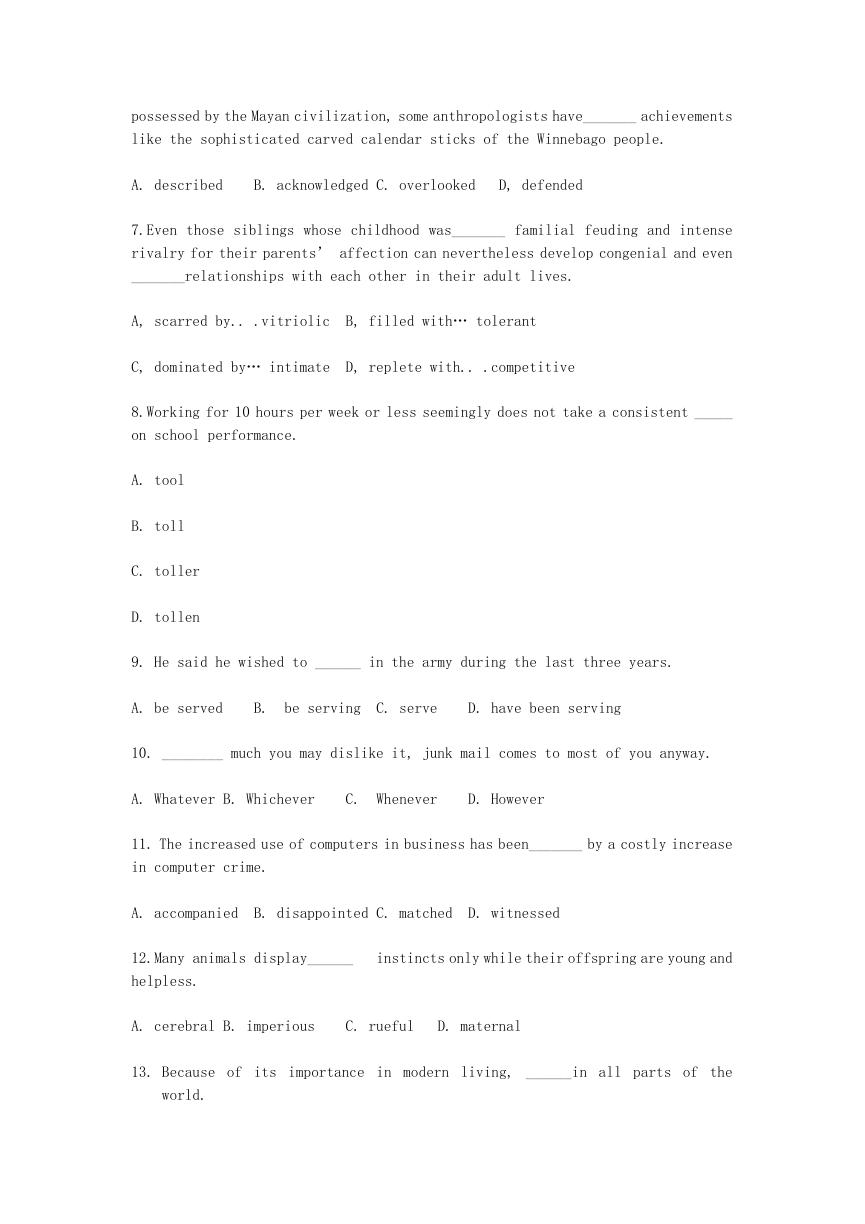
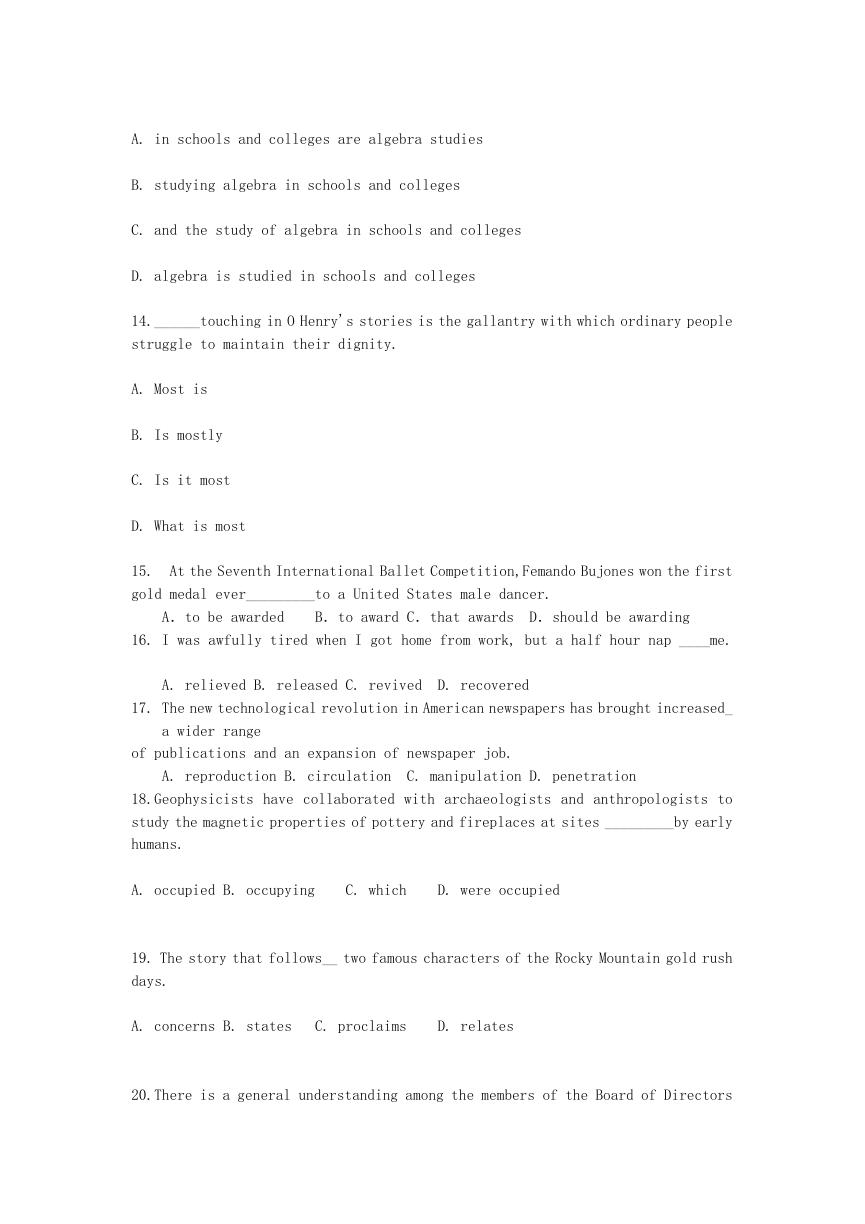
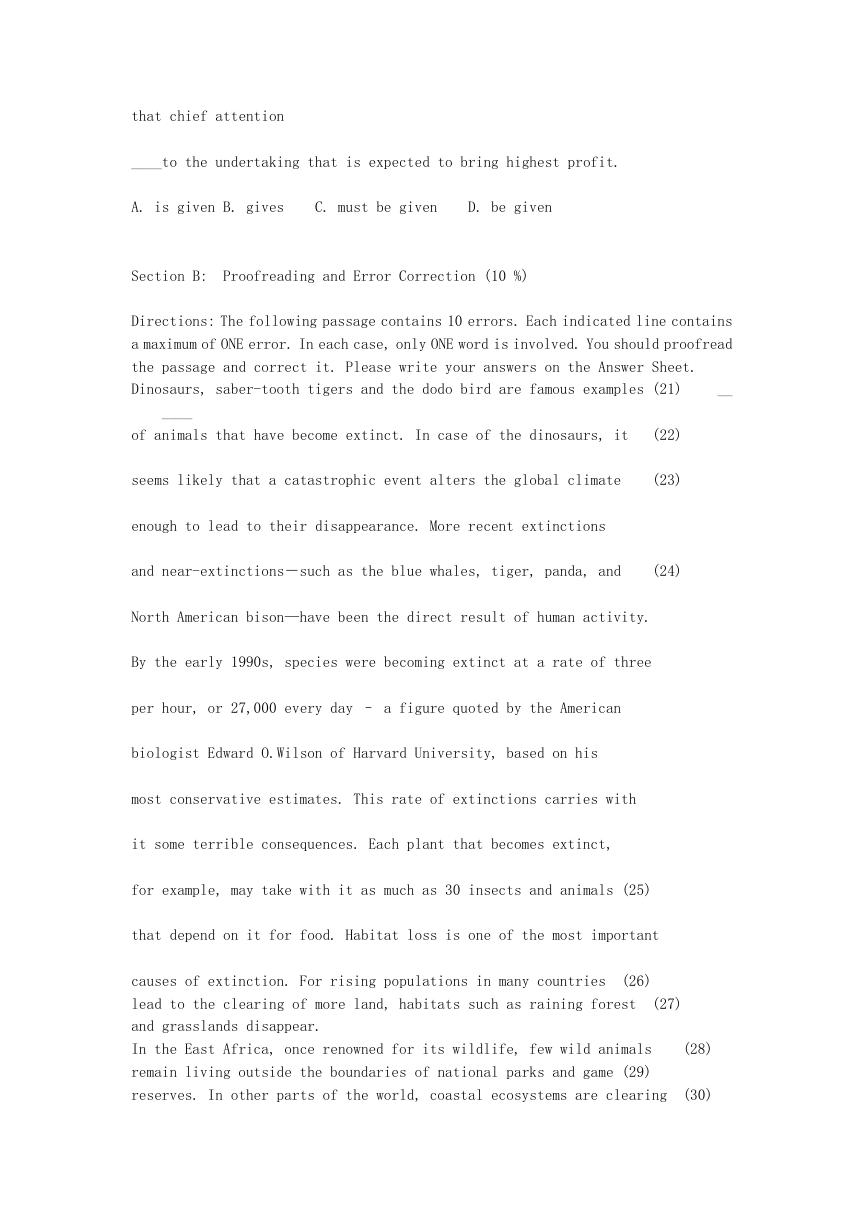
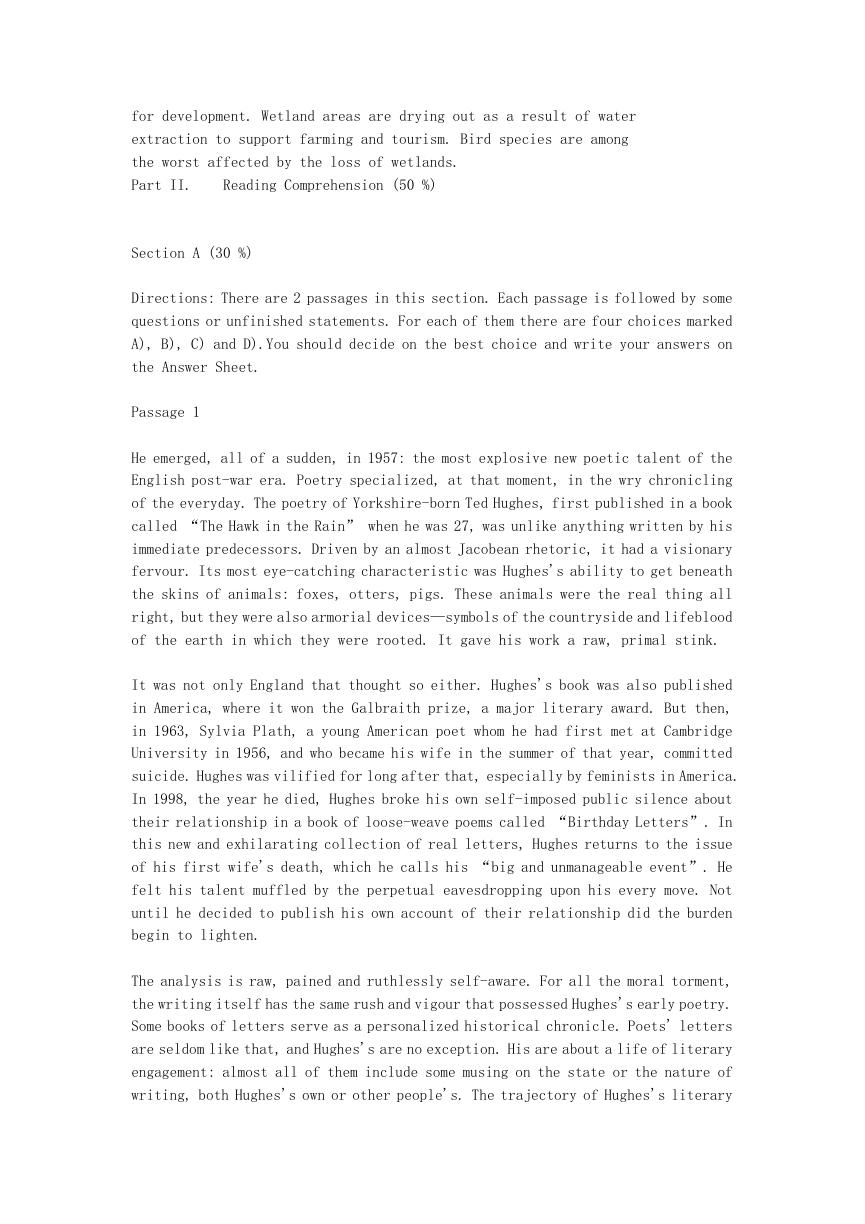
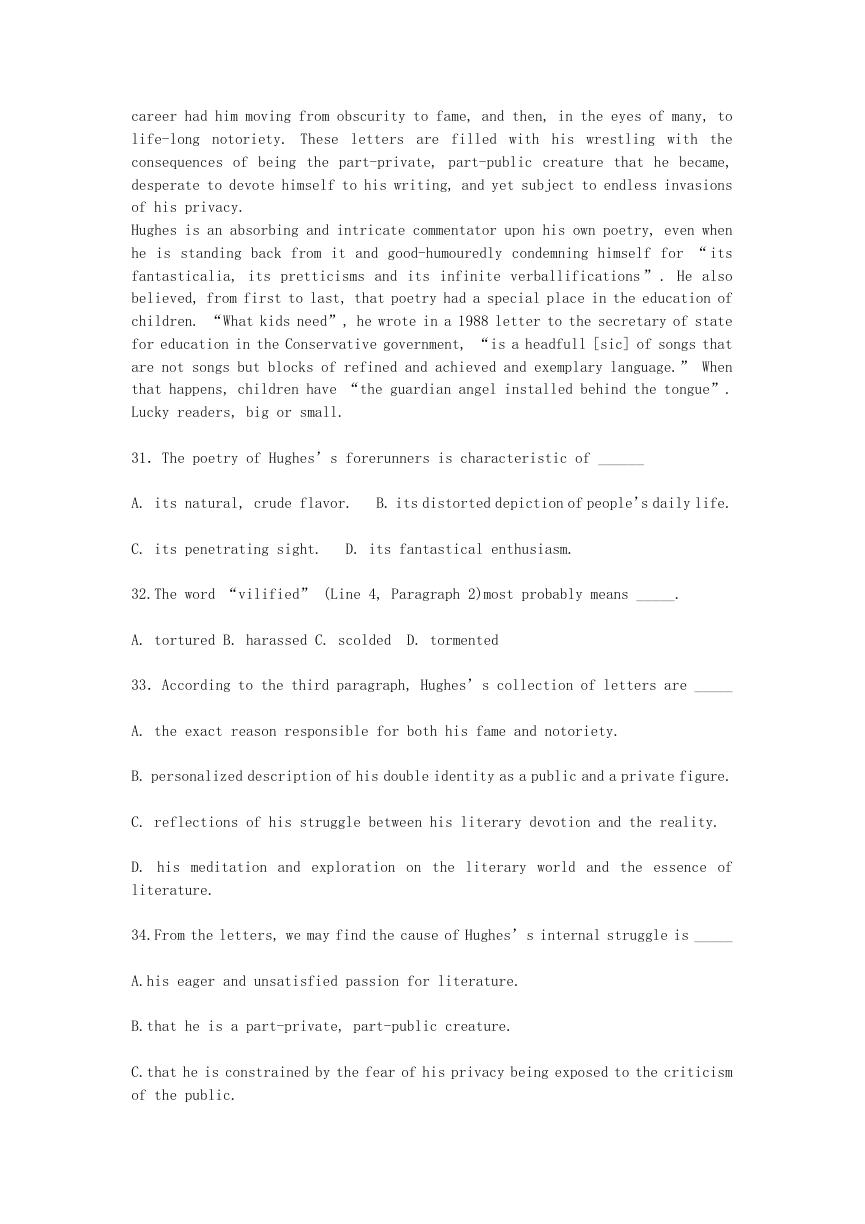
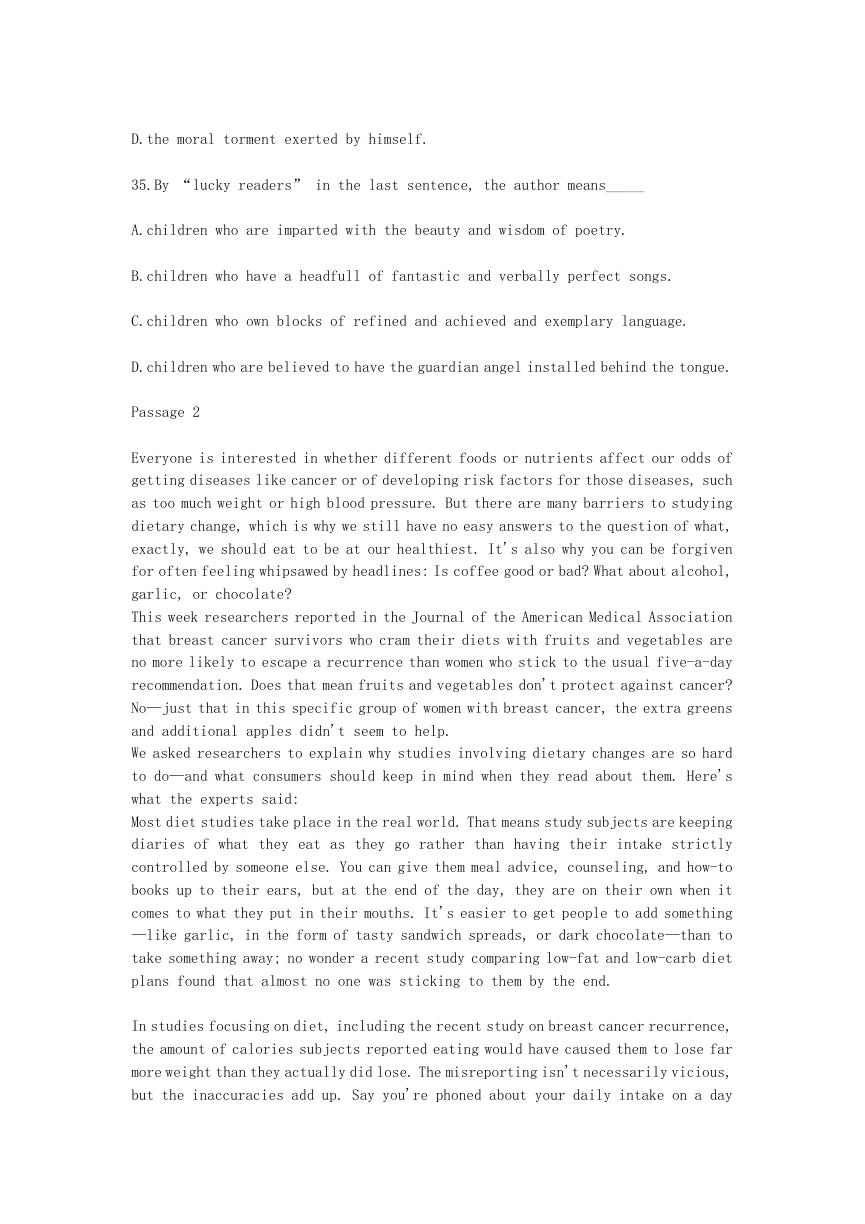
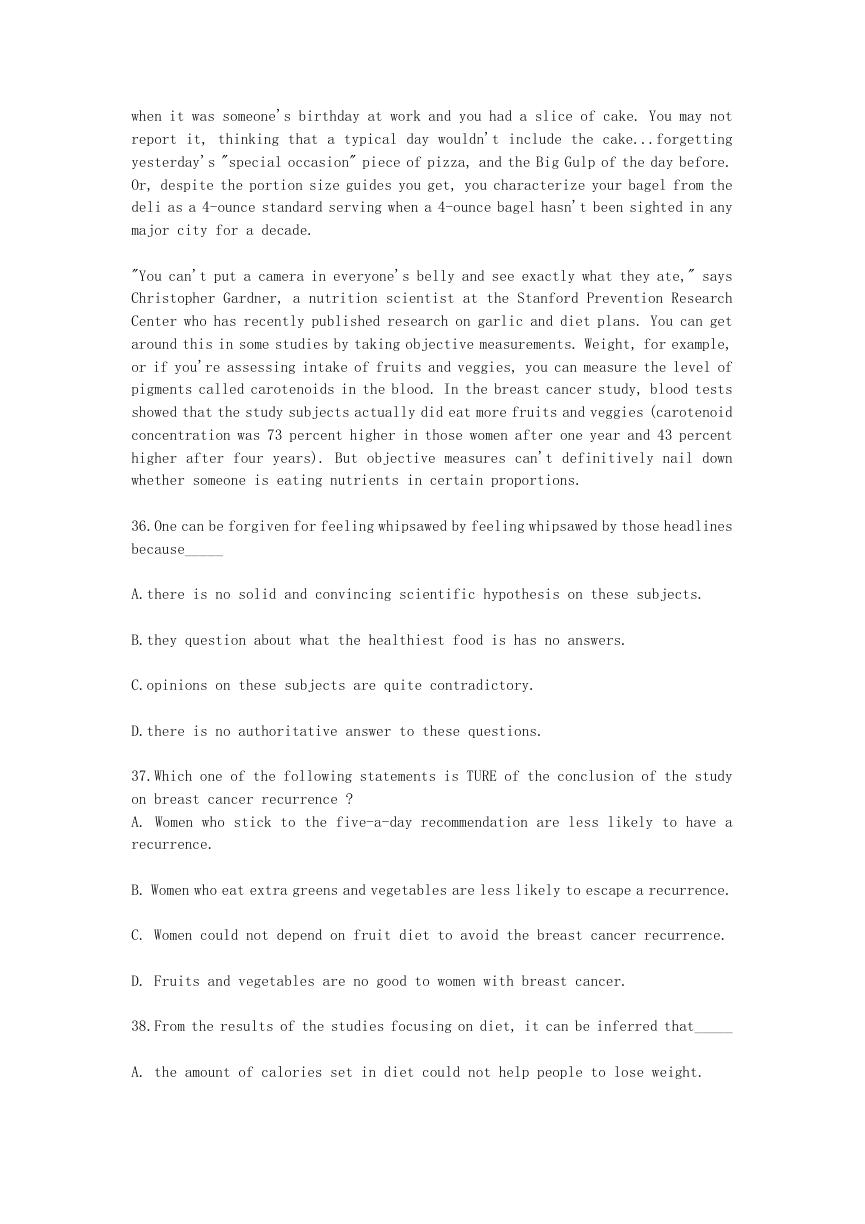








 2023年江西萍乡中考道德与法治真题及答案.doc
2023年江西萍乡中考道德与法治真题及答案.doc 2012年重庆南川中考生物真题及答案.doc
2012年重庆南川中考生物真题及答案.doc 2013年江西师范大学地理学综合及文艺理论基础考研真题.doc
2013年江西师范大学地理学综合及文艺理论基础考研真题.doc 2020年四川甘孜小升初语文真题及答案I卷.doc
2020年四川甘孜小升初语文真题及答案I卷.doc 2020年注册岩土工程师专业基础考试真题及答案.doc
2020年注册岩土工程师专业基础考试真题及答案.doc 2023-2024学年福建省厦门市九年级上学期数学月考试题及答案.doc
2023-2024学年福建省厦门市九年级上学期数学月考试题及答案.doc 2021-2022学年辽宁省沈阳市大东区九年级上学期语文期末试题及答案.doc
2021-2022学年辽宁省沈阳市大东区九年级上学期语文期末试题及答案.doc 2022-2023学年北京东城区初三第一学期物理期末试卷及答案.doc
2022-2023学年北京东城区初三第一学期物理期末试卷及答案.doc 2018上半年江西教师资格初中地理学科知识与教学能力真题及答案.doc
2018上半年江西教师资格初中地理学科知识与教学能力真题及答案.doc 2012年河北国家公务员申论考试真题及答案-省级.doc
2012年河北国家公务员申论考试真题及答案-省级.doc 2020-2021学年江苏省扬州市江都区邵樊片九年级上学期数学第一次质量检测试题及答案.doc
2020-2021学年江苏省扬州市江都区邵樊片九年级上学期数学第一次质量检测试题及答案.doc 2022下半年黑龙江教师资格证中学综合素质真题及答案.doc
2022下半年黑龙江教师资格证中学综合素质真题及答案.doc